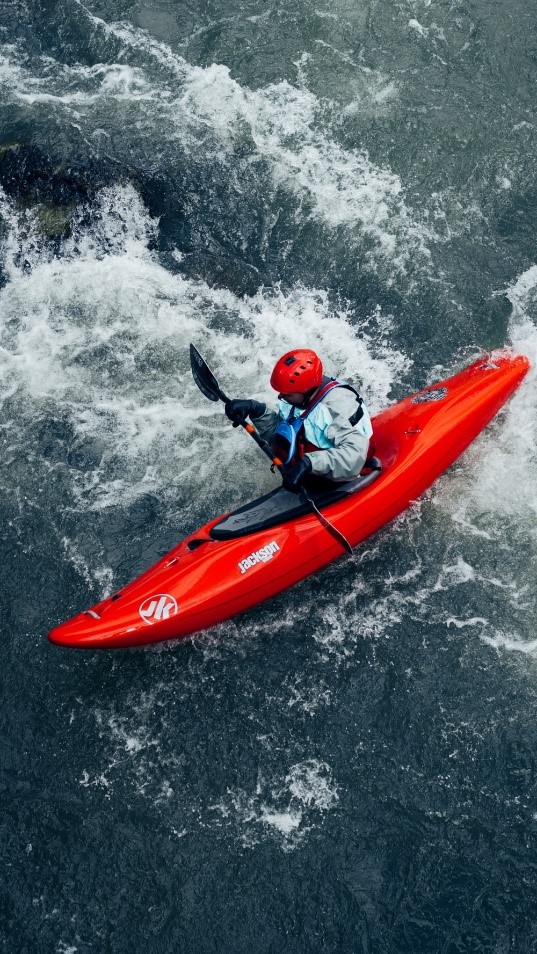Kayaking through different types of waterways is such a thrill. It doesn’t matter if you’re going through a sea filled with waves, a glass-like lake or a winding river; there’s always so much beauty to behold and wildlife to experience. Many kayakers will rent their kayaks at the location they plan on visiting; others choose to own their boat. When purchasing a kayak, it can be difficult to decide between an inflatable kayak vs hardshell kayak.

Don’t stress. We’ve got you covered. We’ve gone ahead and put together this guide to help you make the best decision about which type of kayak you should purchase. So, here are some handy facts to help you choose between an inflatable or hardshell kayak.
Table of Contents
Inflatable Kayak vs Hardshell – Which One Should You Choose?
What Is Each Kayak Made From?
Kayaks can be made from various materials. A rigid kayak, also known as a hardshell kayak, is made from composite materials (i.e., Kevlar), fiberglass, plastic and wood. They typically weigh around 55 pounds, which is quite heavy for a kayak.
An inflatable kayak is lighter than a hardshell or plastic kayak and weighs around 25 pounds. An inflatable boat like this is made from plastic polymers and synthetic rubber materials, which lends to its lighter weight.
Which Kayak Costs More?
When price comes into the picture, you’ll find that an inflatable kayak is much more affordable than a hardshell kayak. However, don’t think these kayaks lack durability because they’re more affordable.
Inflatable kayaks have grown more popular over the years because of their tough and durable construction and their ability to tackle rough water conditions.
They tend to be sturdier because they’re made from multiple air chambers that help lower the risk of the kayak experiencing leaks and tears. This type of inflatable kayak is more expensive than others you’ll find on the market, but it’s because they’re made from more durable materials.
Hardshell kayaks cost more because fiberglass and wood cost more than synthetic rubber. Because of maintenance and repairs, wooden kayaks will also cost you more in the long run.
Storage and Transportation
Another key advantage to having an inflatable kayak vs hardshell is that you can deflate the kayak when you’re done with it and store it more easily. This is especially beneficial when you lack storage space.
Once an inflatable boat has been deflated, you can put it into a storage bag or backpack. With hardshell kayaks, you can’t do this. You need to have ample storage space available to properly store your hardshell kayak when it is not in use.
With its hardshell counterpart, you need to have a way to transport it with your vehicle to get it from one place to another. If you don’t already have a vehicle with a roof rack that can handle carrying around a kayak or multiple kayaks, then you’re looking at spending some extra money to upgrade your vehicle.
We’ve researched how to transport a kayak on your truck and a j-rack for you.

Safety
Your priority when riding in a kayak should be the safety of your passengers and yourself. Your passengers could be riding in a tandem kayak or paddling beside you.
For safety reasons, you should always be aware of boating regulations and safety rules – especially when sharing the water with someone else.
It’s also extremely important that you have a kayak that can withstand the type of water you’re navigating. When you’re riding in rough water, such as white water rapids, you should always use a hardshell kayak, although there are specific inflatable kayaks that can be used in some cases.
In the last decade, engineers have started designing inflatable kayaks to handle Class 3 and 4 waters with strong currents. However, you must remember that not every inflatable kayak has been built to withstand these water classes.
So, if you’re curious if inflatable kayaks are safe, you should know that they are as long as you’re in manageable water conditions.
This is why it’s important that you check the owner’s manual for any inflatable kayak you own to see what kind of water it’s suitable for. If it is not suitable for whitewater kayaking, then find something that is.
If you ride in rapid waters a lot, this could be a huge factor in whether you purchase an inflatable kayak vs a hardshell kayak.
An inexperienced kayaker might believe you have to have a hardshell kayak to navigate around rocks. Still, others know that some higher-quality inflatable kayaks have been designed to bounce off rocks when they hit them.
Stability
When it comes to stability, you will usually find that an inflatable kayak offers more directional stability than its hardshell counterpart. Inflatables have a wider beam, which lends to more stability while on the water. An inflatable boat’s multiple air-filled chambers make it much harder to tip than a hardshell kayak.
Weight Capacity
Inflatable kayaks have a high weight threshold, which means they can hold more weight inside the boat than a hardshell kayak.
While most inflatable kayaks weigh about 25 pounds, most can hold up to 500 pounds of weight inside the kayak.
This enables kayakers to take more with them when they go on a kayaking trip – safety equipment, kayak fishing gear, hiking gear, etc. – and inflatable kayaks can handle more accessories.
Inflatable Kayak vs Hardshell: Bottom Line
Inflatable kayaks provide more benefits than a hardshell kayak does. For instance, they’re easier to transport, store and maintain than hardshell kayaks.
Inflatable kayaks of the past weren’t made from the same durable materials that they are made from today. This makes inflatable kayaks much safer to use now.
However, the downside to an inflatable kayak is that they have to be inflated and deflated every time they’re used. But if you’re okay with that, the benefits of an inflatable kayak are immense.
Now that you have some key facts under your belt, we hope you can decide which type of kayak to use.
You won’t make the wrong decision if you follow your gut and read the owner’s manual of each kayak that you look at to ensure that it can handle the type of water you plan on riding in.


